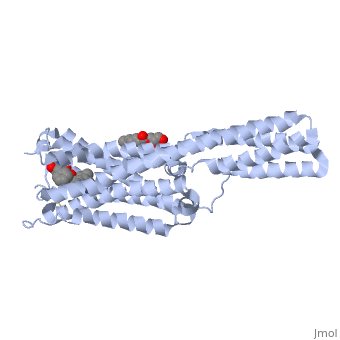Sandbox 77
From Proteopedia
| Line 4: | Line 4: | ||
== Structural highlights/Specific Function of 5-HT1B== | == Structural highlights/Specific Function of 5-HT1B== | ||
| - | The 5-HT1B receptor couples to G-protein alpha subunits Gi and Go. In the central nervous system, this receptor is an inhibitory presynaptic receptor that can alter the release of serotonin, as well as other neurotransmitters, from the presynaptic neuron. The structure of this receptor includes 7 transmembrane alpha-helices in its center. The N-terminal tail of 5-HT1B is close to the ligand binding pocket suggesting some interaction with its ligand. The orthosteric, unmodulated, binding pocket is characterized as a cavity formed from residues of the 3rd, 5th, 6th, and 7th alpha helices and the 2nd extracellular loop. (Wang, et al. 2013) | + | The <scene name='71/716548/5-ht1b/1'>5-HT1B receptor</scene> couples to G-protein alpha subunits Gi and Go. In the central nervous system, this receptor is an inhibitory presynaptic receptor that can alter the release of serotonin, as well as other neurotransmitters, from the presynaptic neuron. The structure of this receptor includes 7 transmembrane alpha-helices in its center. The N-terminal tail of 5-HT1B is close to the ligand binding pocket suggesting some interaction with its ligand. The orthosteric, unmodulated, binding pocket is characterized as a cavity formed from residues of the 3rd, 5th, 6th, and 7th alpha helices and the 2nd extracellular loop. (Wang, et al. 2013) |
== Structural highlights/Specific Function of 5-HT2B== | == Structural highlights/Specific Function of 5-HT2B== | ||
| - | The <scene name='71/716548/5-ht2b_receptor/1'>5-HT2B</scene> | + | The <scene name='71/716548/5-ht2b_receptor/1'>5-HT2B receptor</scene> is important in utilizing serotonin signals to encourage proper development and continuing function of the cardiovascular system. Overexpression of 5-HT2B has been linked to congestive heart failure. (Janssen, et al. 2015) 5-HT2B utilizes the alpha Gq protein pathway which triggers intracellular cGMP production through activation of nictric-oxidase synthase (NOS). (Nebigil, et al. 2001) This receptor is also known for being the target of the drug LSD, which has similar structure to serotonin. (Berumen, et al. 2012) The structure of this receptor is much like that of 5-HT1B. It has the characteristic 7 alpha helices and the N-terminus sticks out into extracellular space. (Wang, et al. 2013) |
== Structural highlights/Specific Function of 5-HT3== | == Structural highlights/Specific Function of 5-HT3== | ||
Revision as of 17:32, 6 December 2015
Contents |
General Function
|
5-HT, Serotonin, receptors are found on the membrane of neurons in the central nervous system and peripheral nervous system. These receptors allow for the body to respond to serotonin and regulate many biological pathways. Serotonin, also known as 5 hydroxytryptamine, is an endogenous neurotransmitter made from tryptophan and is largely found in the gastrointestinal tract. 5-HT receptors are classified into 7 different subfamilies (5-HT1, 5-HT2, 5-HT3, etc.) by signaling mechanisms and homology of structure. All 5-HT receptors are known to have G-protein linked pathways except for the 5-HT3 receptor which acts as an ion channel. (Wang, et al. 2013).
Structural highlights/Specific Function of 5-HT1B
The couples to G-protein alpha subunits Gi and Go. In the central nervous system, this receptor is an inhibitory presynaptic receptor that can alter the release of serotonin, as well as other neurotransmitters, from the presynaptic neuron. The structure of this receptor includes 7 transmembrane alpha-helices in its center. The N-terminal tail of 5-HT1B is close to the ligand binding pocket suggesting some interaction with its ligand. The orthosteric, unmodulated, binding pocket is characterized as a cavity formed from residues of the 3rd, 5th, 6th, and 7th alpha helices and the 2nd extracellular loop. (Wang, et al. 2013)
Structural highlights/Specific Function of 5-HT2B
The is important in utilizing serotonin signals to encourage proper development and continuing function of the cardiovascular system. Overexpression of 5-HT2B has been linked to congestive heart failure. (Janssen, et al. 2015) 5-HT2B utilizes the alpha Gq protein pathway which triggers intracellular cGMP production through activation of nictric-oxidase synthase (NOS). (Nebigil, et al. 2001) This receptor is also known for being the target of the drug LSD, which has similar structure to serotonin. (Berumen, et al. 2012) The structure of this receptor is much like that of 5-HT1B. It has the characteristic 7 alpha helices and the N-terminus sticks out into extracellular space. (Wang, et al. 2013)
Structural highlights/Specific Function of 5-HT3
The is a pentameric cation-selective ion channel and plays a role in neuronal excitation to release neurotransmitters from the postsynaptic neuron. 5-HT3 is usually comprised of subunits A or A and B which can result in a homopentameric receptor or a heteropentameric receptor respectively. 5-HT3 is a transmembrane channel that is stimulated to open state by the interaction of the receptor with serotonin in the extracellular space. The binding site is comprised of six loops from two adjacent subunits.The transmembrane region is comprised of multiple alpha helical structures and mediates ion flow and ion specificity. Sodium and Potassium ions are allowed to pass through the 5-HT3 receptor pore. This receptor is involved in the transfer of information to the gastrointestinal tract which makes it a target of drugs which repress vomiting and irritable bowel syndrome.
References
1. Pancholi, V. "Multifunctional a-Enolase: Its Role in Diseases." CMLS, Cellular and Molecular Life Sciences 58 (2001): 902-20.
2. Pancholi, V. "Multifunctional a-Enolase: Its Role in Diseases." CMLS, Cellular and Molecular Life Sciences 58 (2001): 902-20.
3. Pancholi, V. "Multifunctional a-Enolase: Its Role in Diseases." CMLS, Cellular and Molecular Life Sciences 58 (2001): 902-20.
4. Pancholi, V. "Multifunctional a-Enolase: Its Role in Diseases." CMLS, Cellular and Molecular Life Sciences 58 (2001): 902-20.
5. Pancholi, V. "Multifunctional a-Enolase: Its Role in Diseases." CMLS, Cellular and Molecular Life Sciences 58 (2001): 902-20.
6. Pancholi, V. "Multifunctional a-Enolase: Its Role in Diseases." CMLS, Cellular and Molecular Life Sciences 58 (2001): 902-20.

